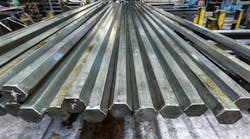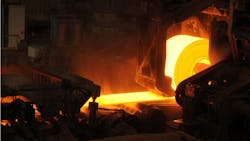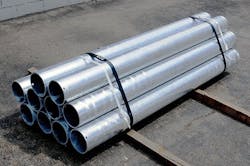This article was updated Feb. 3, 2023. It was originally published June 7, 2016.
Hot and cold rolled steel are two common types of steel. Engineers need to know the difference between them to turn out the best products at the best prices possible.
So how do they differ?
RELATED: Cast Iron and Wrought Iron: What’s the Difference?
The basic difference between these two steels is how they are processed. Hot rolling refers to processing done with heat, while cold rolling is done at or near room temperature. This difference affects overall performance, but it has nothing to do with the steel’s formal specifications and grades, which are a function of metallurgical composition and performance ratings. Steels of different grades and specifications can be hot or cold rolled, including basic carbon and other steel alloys.
Hot Rolled Steel
Hot rolled steel is roll-pressed at temperatures over 1,700°F, which are above most steels’ re-crystallization temperatures. Hot pressing makes steel easier to form and work with.
Making hot rolled steel begins with a large, rectangular billet of steel. It gets heated, flattened into a sheet, and rolled up. While still white hot, it travels through a series of compression rollers that presses it into its finished dimensions.
The hot rolled steel is cooled after processing and it shrinks slightly as it cools. So there is little control over its final shape, making it less-than-ideal for precision applications. It is usually used only when specific dimensions aren’t crucial such as for railroad tracks and construction projects.
Hot rolled steel has the following characteristics:
- Scaled surfaces due to cooling from extreme temperatures.
- Slightly rounded edges and corners for bar and plate products due to shrinkage and imprecise finishing.
- Slight distortions due to cooling leaving slightly trapezoidal forms rather than perfectly squared angles.
Hot rolled steel typically requires much less processing than cold rolled steel, which makes it much less expensive. Hot rolled steel also cools at room temperature, so it’s free from internal stresses that can arise during quenching and work-hardening.
Hot rolled steel is ideal where dimensional tolerances aren’t as important as overall material strength and where surface finish isn’t a key concern. If surface finish is a concern, grinding, sand blasting, or acid-bath pickling can remove scaling; once removed, companies can apply brush or mirror finishes. Descaled steel also preps the surface for painting and other surface coatings.
Cold Rolled Steel
Cold rolled steel is simply hot rolled steel that has gone through more processing. To get cold rolled steel, manufacturers roll cooled-down hot rolled steel to get more exact dimensions and better surface qualities. But the term “rolled” can describe a host of finishing processes—including turning, grinding, and polishing each of which turns hot rolled stock into more refined products. Technically, “cold rolled” applies only to sheets that get compressed between rollers. But forms like bars and tubes are “drawn,” not rolled. So hot rolled bars and tubes, once cooled, are processed into “cold finished” tubes and bars.
Cold rolled steel has the following characteristics:
- Better surface finishes and closer tolerances.
- Smooth surfaces that can be oily to the touch. • Bars are true and square and often have well-defined edges and corners.
- Tubes have better concentric uniformity and straightness.
Cold-rolled steel with surface characteristics better than hot rolled steel is often used for technically precise applications and where aesthetics are critical. Unfortunately, due to the extra processing, cold finished products come at a higher price.
Cold working can create internal stresses within the steel. So machining cold worked steel by cutting, grinding, or welding it can release tensions and lead to unpredictable warping.
Brad Done was vice president of Reliance Foundry Co. Ltd., British Columbia, Canada when this article was written.



